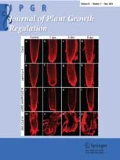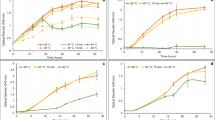Abstract
In this study we tested whether rhizosphere microorganisms can increase drought tolerance to plants growing under water-limitation conditions. Three indigenous bacterial strains isolated from droughted soil and identified as Pseudomonas putida, Pseudomonas sp., and Bacillus megaterium were able to stimulate plant growth under dry conditions. When the bacteria were grown in axenic culture at increasing osmotic stress caused by polyethylene glycol (PEG) levels (from 0 to 60%) they showed osmotic tolerance and only Pseudomonas sp. decreased indol acetic acid (IAA) production concomitantly with an increase of osmotic stress (PEG) in the medium. P. putida and B. megaterium exhibited the highest osmotic tolerance and both strains also showed increased proline content, involved in osmotic cellular adaptation, as much as increased osmotic stress caused by NaCl supply. These bacteria seem to have developed mechanisms to cope with drought stress. The increase in IAA production by P. putida and B. megaterium at a PEG concentration of 60% is an indication of bacterial resistance to drought. Their inoculation increased shoot and root biomass and water content under drought conditions. Bacterial IAA production under stressed conditions may explain their effectiveness in promoting plant growth and shoot water content increasing plant drought tolerance. B. megaterium was the most efficient bacteria under drought (in successive harvests) either applied alone or associated with the autochthonous arbuscular mycorrhizal fungi Glomus coronatum, Glomus constrictum or Glomus claroideum. B. megaterium colonized the rhizosphere and endorhizosphere zone. We can say, therefore, that microbial activities of adapted strains represent a positive effect on plant development under drought conditions.



Similar content being viewed by others
References
Azcón R (1987) Germination and hyphal growth of Glomus mosseae in vitro. Effect of rhizosphere bacteria and cell-free culture media. Soil Biol Biochem 19:417–419
Barea JM, Tobar RM, Azcón-Aguilar C (1996) Effect of a genetically modified Rhizobium meliloti inoculant on the development of arbuscular mycorrhizas, root morphology, nutrient uptake and biomass accumulation in Medicago sativa. New Phytol 134:361–369
Barea JM, Azcón R, Azcón-Aguilar C (2002) Mycorrhizosphere interactions to improve plant fitness and soil quality. Antonie Van Leeuwenhoek 81:343–351
Barea JM, Pozo MJ, Azcón R, Azcón-Aguilar C (2005) Microbial co-operation in the rhizosphere. J Exp Bot 56:1761–1778
Bates LS, Waldren RP, Teare ID (1973) Rapid determination of free proline for water-stress studies. Plant Soil 39:205–207
Bent E, Tuzun S, Chanway CP, Enebak SA (2001) Alterations in plant growth and in root hormone levels of lodgepole pines inoculated with rhizobacteria. Can J Microbiol 47:793–800
Boiero L, Perrig D, Masciarelli O, Pena C, Cassán F, Luna V (2007) Phytohormone production by strains of Bradyrhizobium japonicum and possible physiological and technological implications. Appl Microbiol Biotechnol 74:874–880
Bowen GD, Rovira AD (1999) The rhizosphere and its management to improve plant growth. Adv Agron 66:1–102
Bryla DR, Duniway JM (1997) Water uptake by safflower and wheat roots infected with arbuscular mycorrhizal fungi. New Phytol 136:591–601
Caravaca F, Barea JM, Palenzuela J, Figueroa D, Alguacil MM, Roldán A (2002) Establishment of shrubs species in a degraded semiarid site after inoculation with native or allochthonous arbuscular mycorrhizal fungi. Appl Soil Ecol 22:103–111
Epstein E, Cohen JD (1981) Microscale preparation of pentafluorobenzyl esters: electron-capture gas chromatographic detection of indole-3-acetic acid from plants. J Chromatogr 209:413–420
Galleguillos C, Aguirre C, Barea JM, Azcón R (2000) Growth-promoting effect of two Sinorhizobium meliloti strains (a wild type and its genetically modified derivative) on a non-legume plant species in specific interaction with two arbuscular mycorrhizal fungi. Plant Sci 159:57–63
Germida JJ, Walley FL (1996) Plant growth-promoting rhizobacteria alter rooting patterns and arbuscular mycorrhizal fungi colonization of field-grown spring wheat. Biol Fertil Soils 23:113–120
Glick B, Patten C, Holguin G, Penrose D (1999) Biochemical and genetic mechanisms used by Growth Promoting Rhizobacteria. Imperial College Press, London
Gray EJ, Smith DL (2005) Intracellular and extracellular PGPR: commonalities and distinctions in the plant-bacterium signaling processes. Soil Biol Biochem 37:395–412
Grayston SJ, Vaughan D, Jones D (1996) Rhizosphere carbon flow in trees, in comparison with annual plants: the importance of root exudation and its impact on microbial activity and nutrient availability. Appl Soil Ecol 5:29–56
Gryndler M, Hrselová H, Stríteská D (2000) Effect of soil bacteria on hyphal growth of the arbuscular mycorrhizal fungus Glomus claroideum. Folia Microbiol 45:545–551
James EK, Gyaneshwar P, Mathan N, Barraquio WL, Reddy PM, Iannetta PPM, Olivares FL, Ladha JK (2002) Infection and colonization of rice seedlings by the plant growth-promoting bacterium Herbaspirillum seropedicae Z67. Mol Plant Microbe Interactions 15:894–906
Kennedy AC, Smith KL (1995) Soil microbial diversity and the sustainability of agricultural soils. Plant Soil 170:75–86
Marulanda A, Azcón R, Ruíz-Lozano JM (2003) Contribution of six arbuscular mycorrhizal fungal isolates to water uptake by Lactuca sativa plants under drought stress. Physiol Plant 119:526–533
Marulanda A, Barea JM, Azcón R (2006) An indigenous drought-tolerant strain of Glomus intraradices associated with a native bacterium improves water transport and root development in Retama sphaerocarpa. Microb Ecol 52:670–678
Marulanda A, Porcel R, Barea JM, Azcón R (2007) Drought tolerance and antioxidant activities in lavender plants colonized by native drought-tolerant or drought-sensitive Glomus species. Microb Ecol 54:543–552
Marulanda A, Azcón R, Ruíz-Lozano JM, Aroca R (2008) Differential effects of a Bacillus megaterium strain on Lactuca sativa plant growth depending on the origin of the arbuscular mycorrhizal fungus coinoculated: physiologic and biochemical traits. J Plant Growth Regul 27:10–18
Medina A, Probanza A, Manero FJG, Azcón R (2003) Interactions of arbuscular-mycorrhizal fungi and Bacillus strains and their effects on plant growth, microbial rhizosphere activity (thymidine and leucine incorporation) and fungal biomass (ergosterol and chitin). Appl Soil Ecol 22:15–28
Murashige T, Skoog F (1962) A revised medium for rapid growth and bioassays with tobacco tissue cultures. Physiol Plant 15:473–497
Paleg LG, Stewart GR, Bradbeer JW (1984) Proline and glycine betaine influence protein solvation. Plant Physiol 75:974–978
Prinsen E, Van Laer S, Öden S, Van Onckelen H (2000) Auxin analysis. In: Tucker GA, Roberts JA (eds) Methods in molecular biology, vol 141. Plant Hormone Protocols. Humana Press, Totowa, NJ, pp 49–65
Ruíz-Lozano JM, Azcón R (1995) Hyphal contribution to water uptake in mycorrhizal plants as affected by the fungal species and water status. Physiol Plant 95:472–478
Ruíz-Lozano JM, Azcón R (2000) Symbiotic efficiency and infectivity of an autochthonous arbuscular mycorrhizal Glomus sp. from saline soils and Glomus deserticola under salinity. Mycorrhiza 10:137–143
Ruíz-Lozano JM, Azcón R, Palma JM (1996) Superoxide dismutase activity in arbuscular mycorrhizal Lactuca sativa plants subjected to drought stress. New Phytol 134:327–333
Ruíz-Lozano JM, Collados C, Barea JM, Azcón R (2001) Cloning of cDNAs encoding SODs from lettuce plants which show differential regulation by arbuscular mycorrhizal symbiosis and by drought stress. J Exp Bot 52:2241–2242
Souchie EL, Azcón R, Barea JM, Saggin-Júnior OJ, Ribeiro da Silva EM (2007) Indolacetic acid production by P-solubilizing microorganisms and interaction with arbuscular mycorrhizal fungi. Acta Sci Biol Sci 29:315–320
Valdenegro M, Barea JM, Azcón R (2001) Influence of arbuscular-mycorrhizal fungi, Rhizobium meliloti strains and PGPR inoculation on the growth of Medicago arborea used as model legume for re-vegetation and biological reactivation in a semi-arid Mediterranean area. Plant Growth Regul 34:233–240
Vanstockem M, Michiels K, Vanderleyden J, Van Gool AP (1987) Transposon mutagenesis of Azospirillum brasilense and Azospirillum lipoferum: physical analysis of Tn5 and Tn5-mob insertion mutants. Appl Environ Microbiol 53:410–415
Vessey KV (2003) Plant growth promoting rhizobacteria as biofertilizers. Plant Soil 255:571–586
Vivas A, Azcón R, Biró B, Barea JM, Ruíz-Lozano JM (2003a) Influence of bacterial strains isolated from lead-polluted soil and their interactions with arbuscular mycorrhizae on the growth of Trifolium pratense L. under lead toxicity. Can J Microbiol 49:577–588
Vivas A, Biró B, Campos E, Barea JM, Azcón R (2003b) Symbiotic efficiency of autochthonous arbuscular mycorrhizal fungus (G. mosseae) and Brevibacillus sp. isolated from cadmium polluted soil under increasing cadmium levels. Environ Pollut 126:179–189
Vivas A, Marulanda A, Ruíz-Lozano JM, Barea JM, Azcón R (2003c) Influence of a Bacillus sp. on physiological activities of two arbuscular mycorrhizal fungi and on plant responses to PEG-induced drought stress. Mycorrhiza 13:249–256
Vivas A, Vörös A, Biró B, Barea JM, Ruíz-Lozano JM, Azcón R (2003d) Beneficial effects of indigenous Cd-tolerant and Cd-sensitive Glomus mosseae associated with a Cd-adapted strain of Brevibacillus sp. in improving plant tolerance to Cd contamination. Appl Soil Ecol 24:177–186
Vivas A, Biró B, Ruíz-Lozano JM, Barea JM, Azcón R (2006) Two bacterial strains isolated from a Zn-polluted soil enhance plant growth and mycorrhizal efficiency under Zn-toxicity. Chemosphere 62:1523–1533
Author information
Authors and Affiliations
Corresponding author
Rights and permissions
About this article
Cite this article
Marulanda, A., Barea, JM. & Azcón, R. Stimulation of Plant Growth and Drought Tolerance by Native Microorganisms (AM Fungi and Bacteria) from Dry Environments: Mechanisms Related to Bacterial Effectiveness. J Plant Growth Regul 28, 115–124 (2009). https://doi.org/10.1007/s00344-009-9079-6
Received:
Accepted:
Published:
Issue Date:
DOI: https://doi.org/10.1007/s00344-009-9079-6




